13-5 Spiral arms are caused by density waves that sweep around our Galaxy
The disk shape of our Galaxy is not difficult to understand. The flattening of spinning matter into a thin disk is what naturally happens when a large number of objects are put into orbit around a common center: Over time the objects tend naturally to orbit in the same plane. This is what happened when our solar system formed from the solar nebula. There a giant cloud of material eventually organized itself into planets, all of which orbit in nearly the same plane. In like fashion, the disk of our Galaxy, which is also made up of a large number of individual objects orbiting a common center, is very flat (see Figure 13-8). Understanding why our Galaxy has spiral arms presents more of a challenge.
The Density-Wave Model
One early explanation for the Galaxy’s spiral structure was that the material in the Galaxy somehow condensed into a spiral pattern from the very start. In this view, once stars, gas, and dust had become concentrated within the spiral arms, the pattern would remain fixed. This would be possible only if the Galaxy rotated like a solid disk (see Figure 13-17b); the fixed pattern would be like the spokes on a rotating bicycle wheel. But the reality is that the Galaxy is not a solid disk. As we have seen, stars, gas, and dust all orbit the galactic center with approximately the same speed, as shown in Figure 13-17a. Let us see why this makes it impossible for a rigid spiral pattern to persist.
Imagine four stars, A, B, C, and D, that originally lay on a line extending outward from the galactic center (Figure 13-21). In a given amount of time, each of the stars travels the same distance around its orbit. But because the innermost star has a smaller orbit than the others, it takes less time to complete one orbit. As a result, a line connecting the four stars is soon bent into a spiral (Figure 13-21b). Moreover, the spiral becomes tighter and tighter with the passage of time (Figures 13-21c and 13-21d). This “winding up” of the spiral arms causes the spiral structure to disappear completely after a few hundred million years—a very brief time compared to the age of our Galaxy, thought to be as much as 13.8 billion (1.38 × 1010) years.
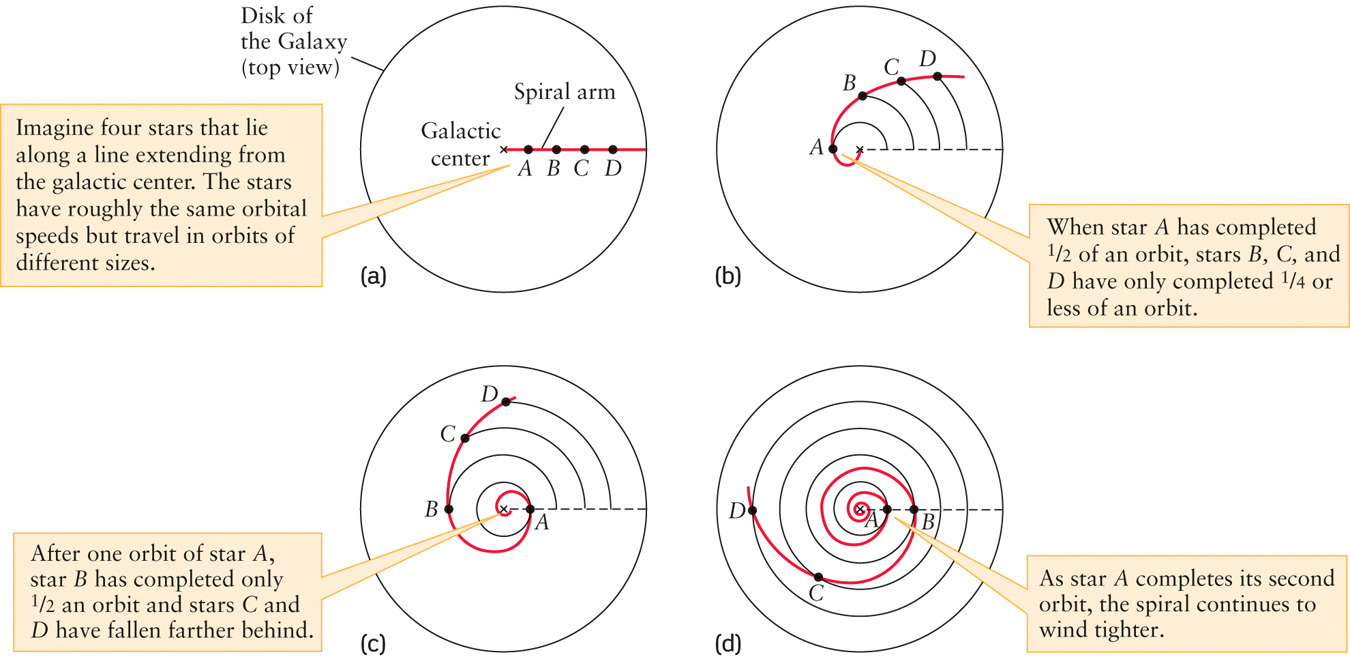
316
Figure 13-21 suggests that the Milky Way’s spiral arms should have disappeared by now. The fact that they have not is puzzling. It shows that the spiral arms cannot simply be assemblages of stars and interstellar matter that travel around the Galaxy together, like a troop of soldiers marching in formation around a flagpole. In other words, the spiral arms cannot be made of anything material. What, then, can the spiral arms be?
In the 1940s, the Swedish astronomer Bertil Lindblad proposed that the spiral arms of a galaxy are actually a pattern that moves through the galaxy like ripples on water. This idea was greatly enhanced and embellished in the 1960s by the American astronomers Chia Chiao Lin and Frank Shu. In this picture, spiral arms are a kind of wave, like the waves that move across the surface of a pond when you toss a stone into the water. Water molecules pile up at a crest of the wave but spread out again when the crest passes. By analogy, Lindblad, Lin, and Shu pictured a pattern of density waves sweeping around the Galaxy. These waves make matter pile up in the spiral arms, which are the crests of the waves. Individual parts of the Galaxy’s material are compressed only temporarily when they pass through a spiral arm. The pattern of spiral arms persists, however, just as the waves made by a stone dropped in the water can persist for some time after the stone has sunk.
To understand better how a density wave operates in a galaxy, think again about a water wave in a pond. If one part of the pond is disturbed by dropping a stone into it, the molecules in that part will be displaced a bit. They will nudge the molecules next to them, causing those molecules to be displaced and to nudge the molecules beyond them. In this way the wave disturbance spreads throughout the pond.
In a galaxy, stars play the role of water molecules. Although stars and interstellar clouds of gas and dust are separated by vast distances, they can nonetheless exert forces on each other because they are affected by each other’s gravity. If a region of above-average density should form, its gravitational attraction will draw nearby material into it. The displacement of this material will change the gravitational force that it exerts on other parts of the galaxy, causing additional displacements. In this way a spiral-shaped density wave can travel around the disk of a galaxy.
ANALOGY
A key feature of density waves is that they move more slowly around a galaxy than do stars or interstellar matter. To visualize this, imagine workers painting a line down a busy freeway (Figure 13-22). The cars normally cruise along the freeway at high speed, but the crew of painters is moving much more slowly. When the cars come upon the painters, they must slow down temporarily to avoid hitting anyone. As seen from the air, cars are jammed together around the painters. An individual car spends only a few moments in the traffic jam before resuming its usual speed, but the traffic jam itself lasts all day, inching its way along the road as the painters advance.

317
A similar crowding takes place when interstellar matter enters a spiral arm. This crowding plays a key role in the formation of stars and the recycling of the interstellar medium. As interstellar gas and dust moves through a spiral arm, it is compressed into new nebulae (Figure 13-23). This compression begins the very important rebirthing process by which new stars form.
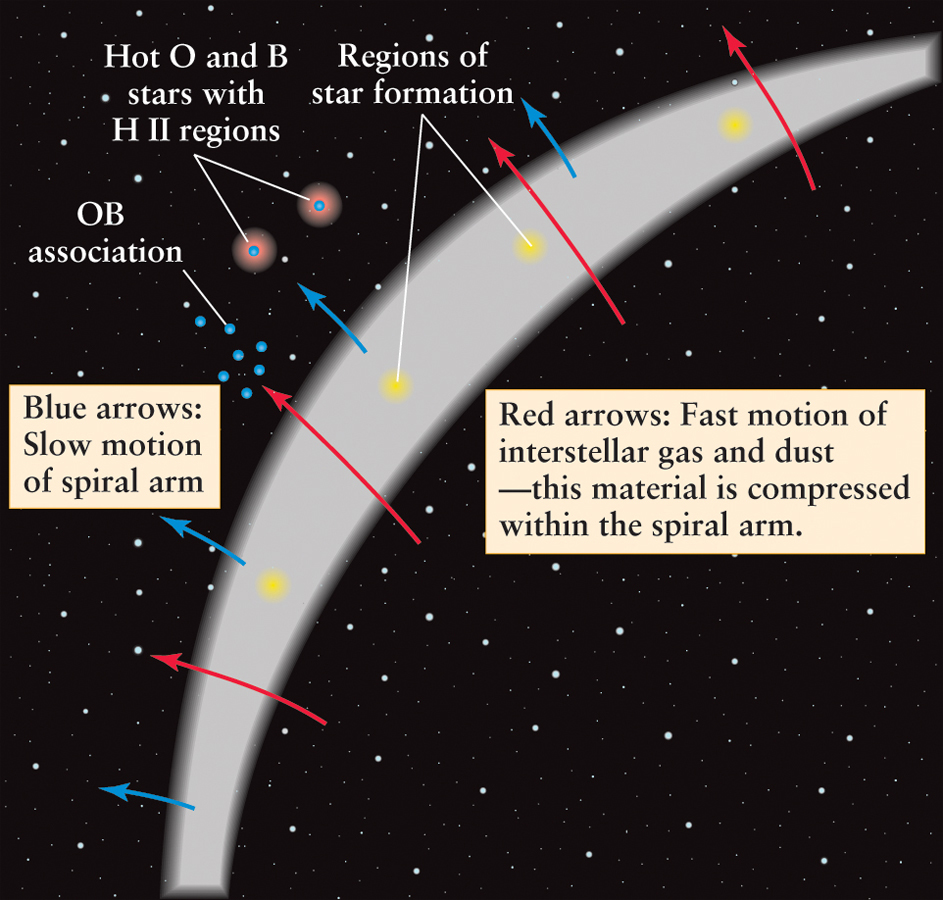
These freshly formed stars continue to orbit around the center of their galaxy, just like the matter from which they formed. The most luminous among these are the hot, massive, blue O and B stars, which may have emission nebulae (H II regions) associated with them. These stars have main-sequence lifetimes of only 3 million to 15 million years, which is very short compared to the 220 million years required for the Sun to make a complete orbit around the Galaxy.
Stars are evenly spread across our Galaxy’s disk, but new stars within interstellar clouds clump into spiral arms.
As a result, these luminous O and B stars can travel only a relatively short distance before dying off. Therefore, these stars, and their associated H II regions, are only seen in or slightly “downstream” of the spiral arm in which they formed. Figure 13-24 illustrates this for the spiral galaxy M51. Less massive stars have much longer main-sequence lifetimes, and thus their orbits are able to carry them all around the galactic disk. These less-luminous stars are found throughout the disk, including between the spiral arms (see Figure 13-15c).
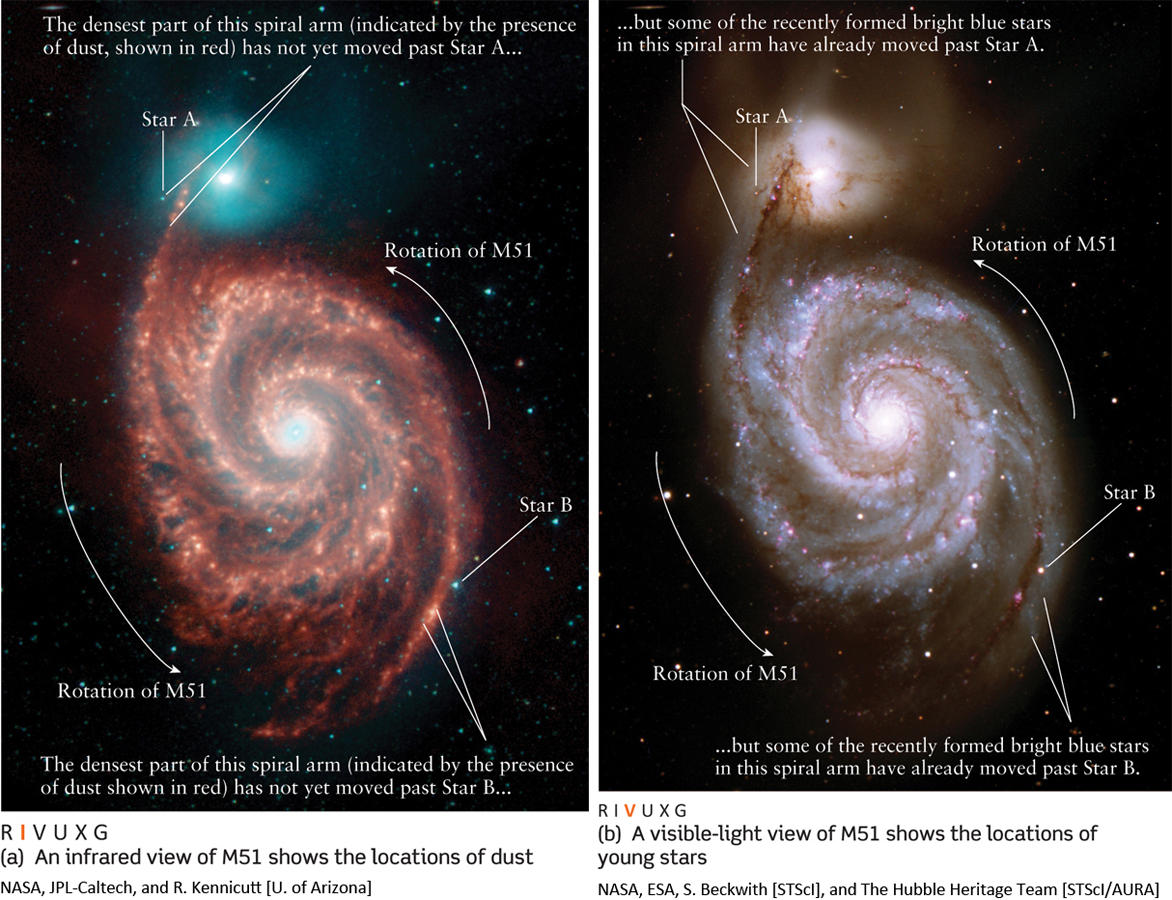
318
The density-wave model of spiral arms explains why the disk of our Galaxy is dominated by metal-rich Population I stars. Because the material left over from the death of ancient stars is rich in heavy elements, new generations of stars formed in spiral arms are likely to be more metal-rich than their ancestors. Cosmic Connections: Stars in the Milky Way illustrates this cycle of star birth and death within the disk of our Galaxy.
The density-wave model is still under development. One problem is finding a driving mechanism that keeps density waves going in spiral galaxies. After all, density waves expend an enormous amount of energy to compress the interstellar gas and dust. Hence, we would expect that density waves should eventually die away, just as do ripples on a pond. The American astronomers Debra and Bruce Elmegreen have suggested that gravity can supply that needed energy. As stated earlier, the central bulge of our Galaxy is elongated into a bar shape, much like the central bulge of the galaxy M83 (see Figure 13-15 and Figure 13-16). The asymmetric gravitational field of such a bar pulls on the stars and interstellar matter of a galaxy to generate density waves. Another factor that may help to generate and sustain spiral arms is the gravitational interactions between galaxies, which we will discuss more deeply in the next chapter.
Question
ConceptCheck 13-11: If the Galaxy were not experiencing density waves, what shape would it have?
The Self-Propagating Star-Formation Model
Spiral density waves may not be the whole story behind spiral arms in our Galaxy and other galaxies. The reason is that spiral density waves should produce very well defined spiral arms. We do indeed see many so-called grand-design spiral galaxies (Figure 13-25a), with thin, graceful, and well-defined spiral arms. But in some galaxies, called flocculent spiral galaxies (Figure 13-25b), the spiral arms are broad, fuzzy, chaotic, and poorly defined (“flocculent” means “resembling wool”).
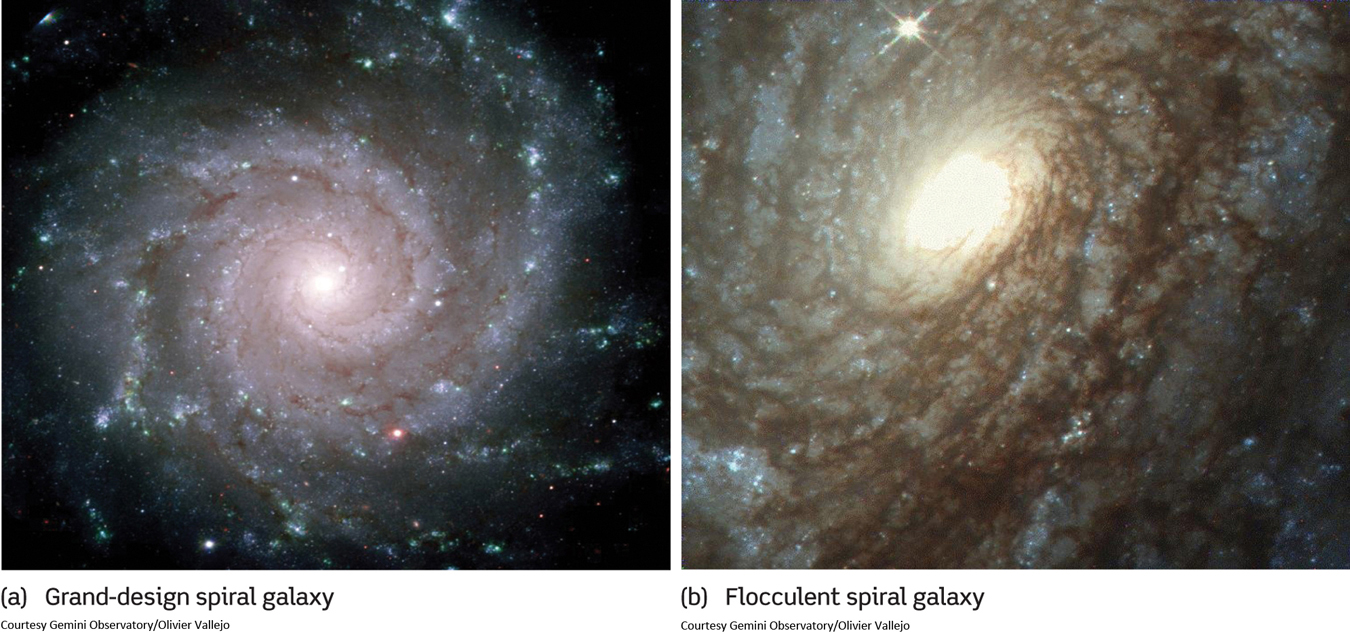
To explain such flocculent spirals, M. W. Mueller and W. David Arnett in 1976 proposed an alternate theory that arms are a natural result of star formation. Imagine that star formation begins in a dense interstellar cloud within the disk of a galaxy that does not yet have spiral arms. As soon as hot, massive stars form, their radiation and stellar winds compress nearby matter, triggering the formation of additional stars in that gas. When massive stars become supernovae, they produce shock waves that further compress the surrounding interstellar medium, thus encouraging still more star formation.
Although all parts of this broad, star-forming region have approximately the same orbital speed about the galaxy’s center, the inner regions have a shorter distance to travel to complete one orbit than the outer regions. As a result, the inner edges of the star-forming region move ahead of the outer edges as the galaxy rotates. The bright O and B stars and their nearby glowing nebulae soon become stretched out in the form of a spiral arm. These spiral arms come and go essentially at random across a galaxy. Bits and pieces of spiral arms appear where star formation has recently begun but fade and disappear at other locations where all the massive stars have died off. This particular genre of star formation therefore tends to produce flocculent spiral galaxies that have a chaotic appearance with poorly defined spiral arms, like the galaxy in Figure 13-25b.
The two theories presented here are very different in character. In the density-wave model, star formation is caused by the spiral arms; in the other approach, by contrast, the spiral arms are instead simply caused by star formation. A complete and correct description of spiral arms in our Galaxy remains a topic of active research.
319
COSMIC CONNECTIONS Stars in the Milky Way
Different populations of stars are found in different neighborhoods of our home galaxy. (The galaxy shown here is another spiral galaxy similar to our own.) The variations from one galactic region to another are due to the presence or absence of ongoing star formation.
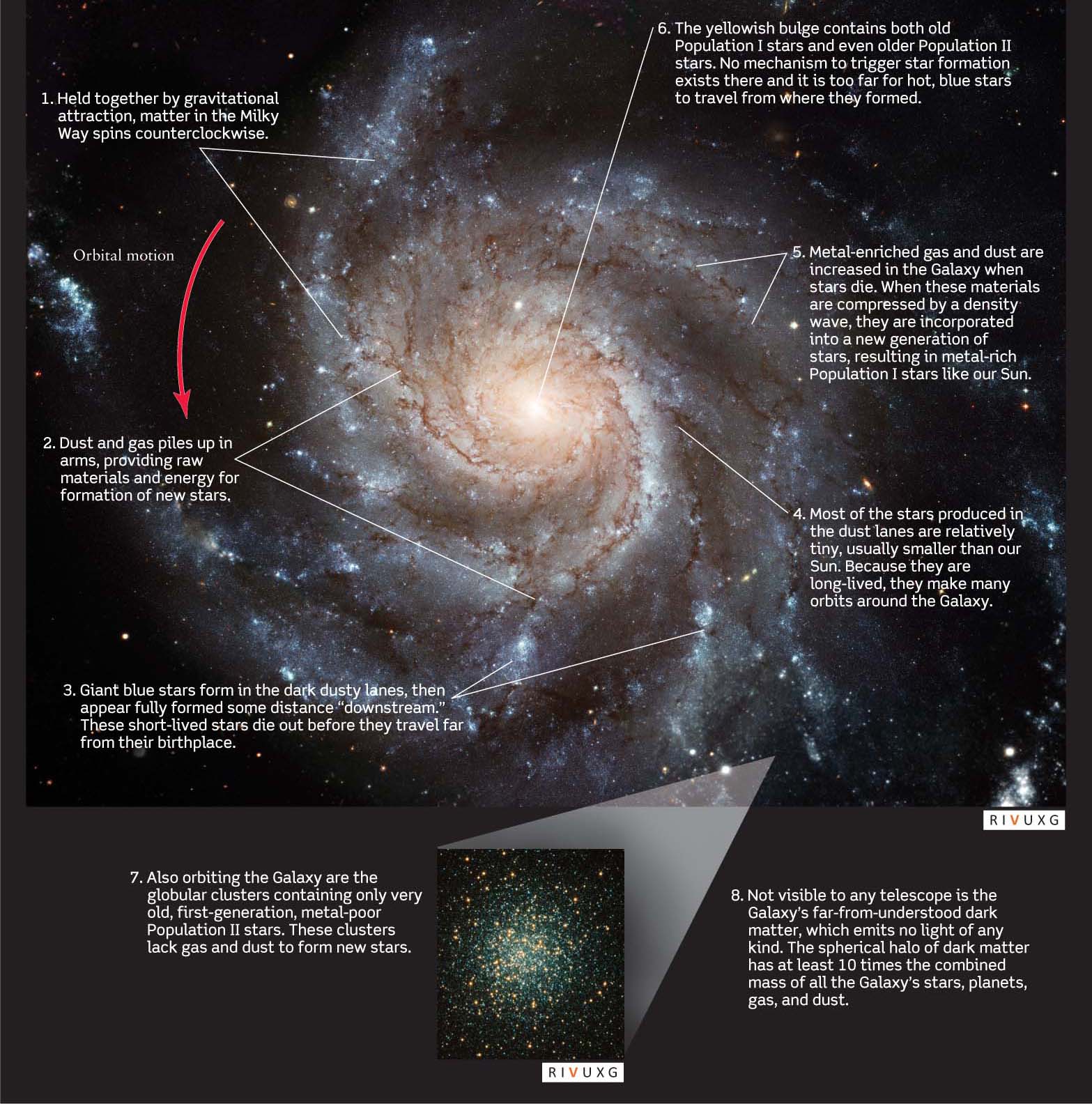
320
Question
ConceptCheck 13-12: If astronomers learned that the earliest galaxies in the universe were flocculent spiral galaxies, what would this suggest about which came first: stars or spiral arms?